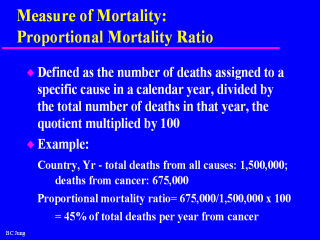 |
While this is an
easy measure to compute, it is also an easy one to misinterpret. For example,
the proportional mortality for accidental deaths may be greater for young
people when compared to the elderly population. Nevertheless, death rates
from accidents is higher among the elderly population simply because of the
numerical impact of the large number of deaths from all causes among the
elderly population. Proportional mortality is very useful in occupational
studies for measuring the relative importance of a specific cause of death.
Unfortunately, one may not necessarily have an essential number - the
population in the denominator. Thus, it does not provide a reliable
population estimate as does the cause-specific death rate, it is
nevertheless useful in making preliminary assessments when denominator data
are unavailable. |
